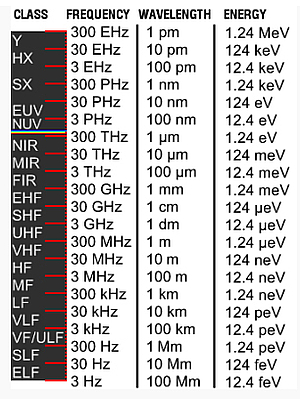As the varganas are electromagnetic, they, like electromagnetic radiations, can be arranged on a spectrum. The vargana spectrum is comprised of all the varganas from the Anu Vargana to Gross Matter Vargana arranged in increasing energy order as was shown in figure 5.1. The first 14 lower varganas exist in unbound form and are mass less; they do not interact with solids, liquids and gases. The higher varganas from 16th PNV-1 to 23rd GMV are 8-touch type and interact with matter. The 15th Intermittent Regular Vargana may exist both in unbound or bonded state that is it may be mass less some time and may have a mass at other time.
The electromagnetic spectrum is the range of all possible frequencies of electromagnetic radiation as shown in figure5.2. The "electromagnetic spectrum" of an object is the characteristic distribution of electromagnetic radiation emitted or absorbed by that particular object. The electromagnetic spectrum extends from low frequencies used in modern radio to gamma radiation at the short-wavelength end, covering wavelengths from thousands of kilometers down to a fraction of the size of an atom. The long wavelength limit is the size of the universe itself, while it is thought that the short wavelength limit is in the vicinity of the Plank length, although in principle the spectrum is infinite and continuous.
Generally, EM radiation is classified by wavelength into radio wave, microwave, infrared, the visible region we perceive as light, ultraviolet, x-rays, gamma rays and cosmic rays. The behaviour of EM radiation depends on its wavelength. Electromagnetic radiation interacts with matter in different ways in different parts of the spectrum. The types of interaction can be so different that it seems to be justifiable to refer to different types of radiation. At the same time, there is a continuum containing all these "different kinds" of electromagnetic radiation. There are no precisely defined boundaries between the bands of electromagnetic spectrum. Radiation of some types has a mixture of the properties of those in two regions of the spectrum. For example, red light resembles infrared radiation in that it can resonate some chemical bonds.

| Legend | ||
| γ= Gamma rays | MIR= Mid infrared | HF= High freq. |
| HX= Hard X-rays | FIR= Far infrared | MF= Medium freq. |
| SX= Soft X-rays | Radio waves | LF= Low freq. |
| EUV= Extremeultraviolet | EHF= Extremely high freq. | VLF= Very low freq. |
| NUV= Near ultraviolet | SHF= Super high freq. | VF/ULF= Voice freq. |
| Visible light | UHF= Ultra high freq. | SLF= Super low freq. |
| NIR= Near Infrared | VHF= Very high freq. | ELF= Extremely low freq. |
| Freq=Frequency |
Fig 5.2 Electromagnetic spectrum
It is interesting to compare the two spectrums. They are seen to have some common features like (1) they have arrangement of electromagnetic entities in a given order, (2) the properties of each electromagnetic entity is different, (3) the boundary between two adjoining entities is not well defined and (4) despite differences in entities there is a continuum justifying the spectrum.
The entities in the two spectrums appear to be of different kinds but we find that Individual Body Vargana of the vargana spectrum compares with the visible light region of the electromagnetic spectrum. This provides a basis for comparison between the two spectrums. The lower order 4-touch vargana must be some part of the lower EM spectrum and the higher order 8touch vargana must form some part of the upper EM spectrum. Knowing that 4-touch vargana do not interact with matter like EM radiation the position of the two types of entities cannot be same on the EM spectrum. It is justifiable to assume that the 4-touch vargana must be placed lower than the lowest EM radiation on the EM spectrum. The paramanu must be at the lowest end of the spectrum. Now considering the lower vargana spectrum we are left with the 15th Intermittent Regular Vargana and the 16th first Permanent Nil Vargana to be compared with the radio waves, microwaves and the infrared regions. Assuming that the upper part of infrared region can combine with the visible region and the lower part with the microwave we are tempted to suppose that the IRV compares with radio waves and the 16th PNV with the microwaves. From this analogy the microwaves are seen to be permanent nil types radiation having mass. The significance of this new possible property of microwaves must be explored.
The comparison of the upper part of vargana spectrum with the EM spectrum is more difficult. The upper vargana spectrum contains two life vargana, the Large Nigod Vargana and the Small Nigod Vargana, which have no equivalents in the EM spectrum. The 22nd PNV is also called Nabho or space vargana and compares with the cosmic rays. The 23rd and the biggest Gross Matter Vargana may have energy greater than the energy of known cosmic rays so that a large number of these vargana may combine to materialize the subatomic particles. The GMV may constitute the highest end of the EM spectrum. Further study of comparison between the two spectrums may prove to be useful.
One important indication of the above comparison is that the 4-touch varganas which constitute the subtle bodies of organisms have very low frequencies and very large wavelengths. Their interaction with the subtle bodies is expected to be similar to the interaction of radio waves with matter. The wavelength of paramanu may be of the size of the loka so that it could cross the loka in one samaya.
 Dr. N.L. Kachhara
Dr. N.L. Kachhara
